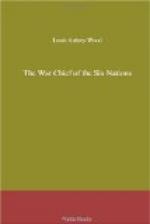As fortune would have it, this ruse was doomed to complete failure. The messengers set out at eleven o’clock at night, and Herkimer thought they would surely reach the fort by three in the morning. But he waited in vain the whole night through; no sound of cannonade disturbed the quiet air. As the hours crept by his officers became fretful and impatient; in the end they declared for an immediate advance, denouncing Herkimer as a faltering coward. At length the old man, sorely against his will, gave the order to march. The relief party streamed through the forest with disordered ranks. In the meantime Brant’s Indians had not been idle. They had carefully watched the manoeuvres of the hostile force, and had given timely warning. St Leger at once took steps to bar the road to attack. For this purpose a division of the Royal Greens was detailed, as well as the Tory Rangers, with Butler in command. The bulk of the contingent, however, were Indians, and it fell to the lot of Joseph Brant to fasten Herkimer in the strong meshes of his net.
The ground over which the Americans had to pass was uneven, and this had not escaped the watchful eye of Brant. He was an adept in the tactics of Indian warfare, and now used his knowledge to good effect. Herkimer had not gone far along the narrow trail before he found himself in difficulties. The road slanted down into a boggy hollow some six or seven miles below Fort Stanwix. This hollow had a winding course in the form of a crescent, and across its march a causeway of heavy logs had been built. Between the ends of the encircling ravine there was an elevated position, thickly wooded and dry. Upon this Brant had laid his ambush, having posted his men with only a slight opening in their ranks towards the incline of the road.
Down into the gully came the colonials, their wagons and a small guard bringing up the rear. As they toiled up the opposing ascent, the gap was closed upon them, and they were surrounded on every side. The rear-guard were left behind with the wagons and fled in a tumult, with a throng of Indians in close pursuit. From the sheltering trees a deadly fusillade swept the hapless files of those who were hemmed about on the rising ground. Darting from their cover, the Indians sprang upon such as lay wounded and dispatched them with knife and tomahawk.
The first onslaught had resulted in a carnival of blood. Now the colonials, owing to their numbers, were able to get together and to place themselves on the defensive. The fight soon became hand to hand and there ensued one of the most gruesome melees of the whole War of the Revolution. The men were able to look into one another’s faces; they fought at quarters too close for bullets, and relied upon gun-stock, knife-blade, and bayonet. There was slashing and cutting, clubbing and throttling, and often in their frenzy they grappled tight and died in one another’s fast embrace. In the midst of it all Herkimer proved himself no craven. With his leg ripped by a bullet he propped himself against a tree, lit his pipe, and directed the order of the battle. Above the din rang out clear the wild cries of the red men, their painted bodies flashing bright among the trees. In the forefront was Brant, fighting vehemently, his towering form set firmly, his deep voice echoing loud.




